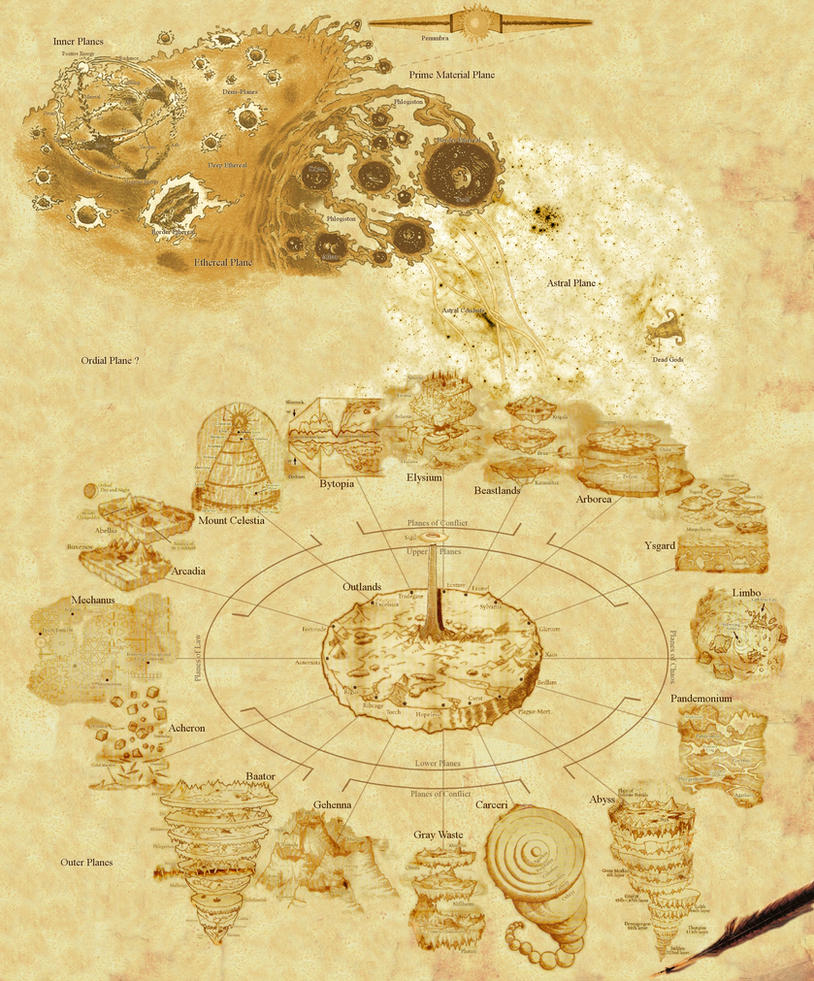In contrast to Fallout 2, which I finished in my early teens, I got around to playing through Planescape: Torment about half a year ago. Just as everyone around the net had said, it was a world to get lost in, with interesting characters, ample amounts of dialogue and a captivating setting that let the imagination flow.
While I could talk at length about the many things that make this game so remarkable, others have already done this many times over; “Final frontier” wrote a good blog post on the subject about a month ago, well worth reading.
Instead, I’d like to talk about what I felt was missing in this beautiful game.
(There will be spoilers, so you might want to finish the game first.)
 The Planescape Multiverse
The Planescape MultiversePlanescape smorgasbord
Throughout the course of the game, the Nameless One will spend most of his time in the city of Sigil, a torus sitting at the top of the infinitely tall mountain Spire. Ruled by the Lady of Pain, it’s a place of absolute neutrality, both with regards to Good versus Evil and Law versus Chaos. It’s a place which the Lady of Pain doesn’t allow to slant to a specific alignment and is therefore used as a hub for creatures from all of the other planes. Also, it’s (if I recall the setting correctly) a place which souls inhabit after arriving from the Prime Material Plane, until they show a definitive alignment which would allow them to travel to the respective plane for that alignment.
Essentially this gives the player the opportunity to experience a tiny piece of every plane.
We get to speak to the Abishai from the world of Lawful-Evil, Baator; unscrupulous creatures speaking of a world where cruelty, treachery and deceit is commonplace. We get to travel with a Githzerai, formerly an inhabitant of the plane of Limbo, an ever-changing place where strong will of the individual actually shapes the world around him. We get to hear the thoughts of a Modron, an inhabitant of Mechanus, an infinite plane constructed out of giant cogs, guarded by gear spirits.
There are so many stories that one gets to hear, but we don’t really get to see them. We get a wealth of excellently crafted samples for tasting, but never the whole meal.
I wanted to see Mount Celestia and its inhabitants, beings embodying Lawful-Good. I wanted to see the verdant plane of Arborea and I wanted to see the home plane of my Githzerai companion, Limbo.
I realize this would have exceeded the budget and scope of the game that Black Isle was creating, but at the end of the game, when I had somewhat digested what a fantastic experience the game was, I couldn’t help but say to myself:
“There’s so much more that I want to see.”
Underwhelming worlds
When I played the game, I found the world so intriguing that I made an effort to talk to as many different characters as possible. The writing of the dialog and the amount of different stories they had to tell kept me glued to the screen. As mentioned above, the imagination was constantly flowing.
This made the occasional trips outside of Sigil disappointing, since I had made up these fantastic worlds in my head which the game could not live up to. Yes, that’s a normal situation, I know: when you have a fantastic place described to you through the medium of text, be it a book or (as in this game) ample amounts of dialogue, an artist’s rendition of that will often disappoint (hence the very often occurrence of “the book was so much better”).
Still, when I set foot in Baator, I expected more than a bunch of hostile creatures amidst some piles of red rocks. Sure the Pillar of Skulls was a deeply satisfying thing to interact with, but the plane which it was on very much wasn’t; Baator was not much more than a gauntlet of enemies.
Carceri was a plane placed between the Gray Waste (Neutral-Evil) and the Abyss (Chaotic-Evil), and yet it didn’t feel much different from the streets of Sigil. It’s supposedly “The prison realm” but the plane’s character or alignment didn’t shine through. Even the city’s descent into chaos due to the influence of Trias didn’t feel as impactful as it could have been. While I was very happy to see that Trias power (drawn from the evil of the citizens) was affected by how many people you converted to make good deeds, the setting itself only changed in the sense that there was an ongoing invasion from the adjacent plane. My imagination had told me that a shift in a plane’s alignment introduced huge changes, where as in the game it was not much more than a shift in the behaviour of the inhabitants.
Once again, I understand that creating something like that costs money and time, something which the developers might not have had at that point, but it’s something that keeps bugging me.
What transpired in Baator and in Carceri was necessary for the story to progress and the events themselves were well written, but the planes left me wishing for far more.
Hope for Numenera
With all of the above said I’d like to reiterate that there’s a great amount of things I could praise the game for. I wrote this because I wanted one of the best games I’ve played to be even better.
With Torment: Tides of Numenera in the hands of a remarkable team, I’m sure that the spiritual successor to Planescape: Torment will be a great experience. What I’m hoping, though, is that they’ll be able keep everything that was great about the original but surpass its scope.
With the team that inExile has assembled, it just might be possible.
